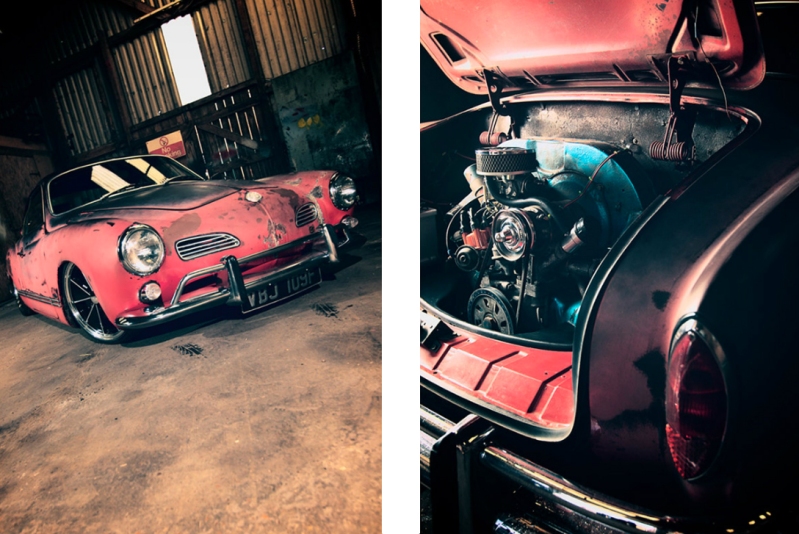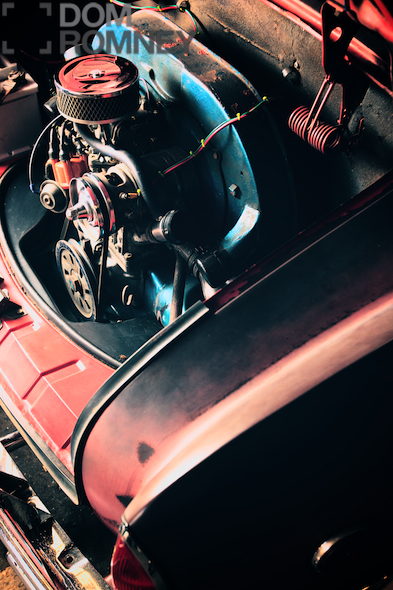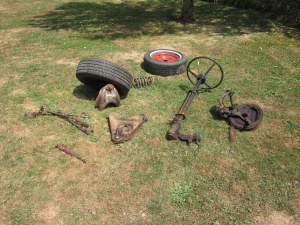
Photos by Roger Kallins.
Of the dozens of Corvettes famously linked to the astronauts of the moon-shot Sixties, only a handful of documented Apollo-era astronaut-owned‘Vettes survive, none of them as original as the 1967 Corvette once owned by the late Neil Armstrong. Now, thanks to a new initiative, that Corvette will undergo a preservation effort that will keep it just as Armstrong had it.
One of the many Corvettes that Florida Chevrolet dealer Jim Rathmann sold to those with the Right Stuff, Armstrong’s Marina Blue mid-year coupe emerged from the St. Louis assembly plant on December 9, 1966, and passed into his possession six days later. Equipped with the 390hp 427-cu.in. V-8, a four-speed transmission, air conditioning, power brakes, power windows, tinted windows, transistorized ignition, and the AM-FM radio, the coupe served Armstrong for the next year, until he traded it in at Rathmann Chevrolet for a 1968 Corvette convertible. A day later, a fellow NASA employee bought it, beginning a 44-year stretch of ownership that ended earlier this year when current owner Joe Crosby bought it.
Crosby, a Corvette restorer from Merritt Island, Florida, actually first got wind of the Corvette in the summer of 1979, when the second owner still had it on the road. “My brother and I both talked about buying it,” Crosby said. “At the time we didn’t know it had something to do with Neil Armstrong, we just knew that it was a big-block car with its original engine. All the Corvettes I’ve restored have had their original engines. But I had two other Corvettes I was working on at the time, so I passed.”

Regardless, he kept in touch with the second owner, calling him about once a year to chat and see if the Corvette was still for sale. At one point over the years the second owner revealed that Armstrong originally owned the Corvette, but the answer always remained no. In the meantime, the second owner moved the Corvette into a heated and air-conditioned garage and put it up on jackstands with the intentions of turning it into a family project. He modified it with fender flares, as was the fashion of the time, but got no farther with it.
Even up to late 2011, the second owner refused to sell, but then one day in late February he called Crosby and asked him if he still wanted to buy it. “It took me about five minutes to get the trailer ready to pick it up,” Crosby said. After getting it home, his initial assessment showed the Corvette to be in largely original condition, apart from the flares, thanks to its 31-year hibernation and the 38,000 miles on the odometer. “The rubber fuel hoses were like potato chips, dry and crumbling, but the gas tank was clean and shiny, and the spare tire had never been out of its carrier.” With careful pre-lubrication and some new lengths of fuel hose, the 427 actually fired up for Crosby. The water pump and mufflers had at some point been replaced, but for an experienced Corvette restorer like Crosby, finding date-coded replacements took little effort. Finding four NOS fenders, however, proved a challenge. “I took a six-week safari around the country to find four GM fenders,” he said. “I paid a fortune for them all, but I could not bring myself to get reproduction fenders if the real ones were still out there.”

As for authenticating the Corvette as Armstrong’s, Rathmann did keep files on all of his astronaut cars, but subsequent owners of the dealership destroyed those records. Still, Armstrong’s name appears on the Protect-O-Plate, and Crosby convinced Jack Legere, a friend of his who works at NASA, to show Armstrong Crosby’s photos of the Corvette during one of Armstrong’s periodic visits to Florida. “He immediately recalled it and grinned ear to ear,” Crosby said. “He didn’t have time then to check it out in person, and we all know what happened next.” Armstrong died in late August at the age of 82.
Up until this summer, Crosby intended to subject the Corvette to a full restoration, as he had with all of his other Corvettes, but then mid-year expert David Burroughs, a champion of original and preserved cars, convinced him to call preservationist Eric Gill of nearby Port Orange, Florida. Like Burroughs, Gill prefers preservation over restoration, particularly when it comes to cars with provenance, such as the Neil Armstrong Corvette. “Preservation is the cutting edge in the hobby right now,” Gill said. “The term is deceptive because some people think it just means sitting on the car, but we’re actually developing protocols for retaining the history of a car, as opposed to wiping away all that history in a restoration. A historically significant car is only as interesting as the people who gave it that history.”

After several conversations between Crosby and Gill, the two put together a team – including restorer/preservationist Allan Scheffling, videographer Chris Hoch, photographer Roger Kallins, and Legere – that will carefully document the Corvette as it sits now and identify steps to take in the coupe’s preservation. “I’m calling this a reactive preservation, which means that we have to react to a situation that exists that is inappropriate to the historical integrity of the car, in this case the fender flares,” Gill said. “We want to take it back to the condition it was in when Neil Armstrong traded it in.”
The hardest part of the preservation, Gill said, will be replacing the flares with sections of unflared fenders and then distressing the new paint over the replaced sections to harmonize with the existing paint. “We won’t be replacing the full fenders, which will inflate the number of hours we’ll have in the car, but will also give us the opportunity to disturb as little of the original paint as possible. We hope to do it in such a way that you can’t tell even though you know it’s been replaced.”
Crosby has since come around to Gill’s line of thinking, at least for this car. “Once you restore a car, you can’t ever go back to the way it was,” Crosby said. “Some people might see it as a beat-up old car, but people like us see that if you undo all that, it’s no longer Neil Armstrong’s car. This isn’t a car, it’s a piece of history, and the chance of having just one car like this is just astronomical.”

Due to the detailed nature of the process that Gill and his team have outlined, they have no set timeline, but they plan to post more information to their website, RecaptureThePast.com, and provide Hemmings Daily with updates to the preservation as it proceeds.



























































